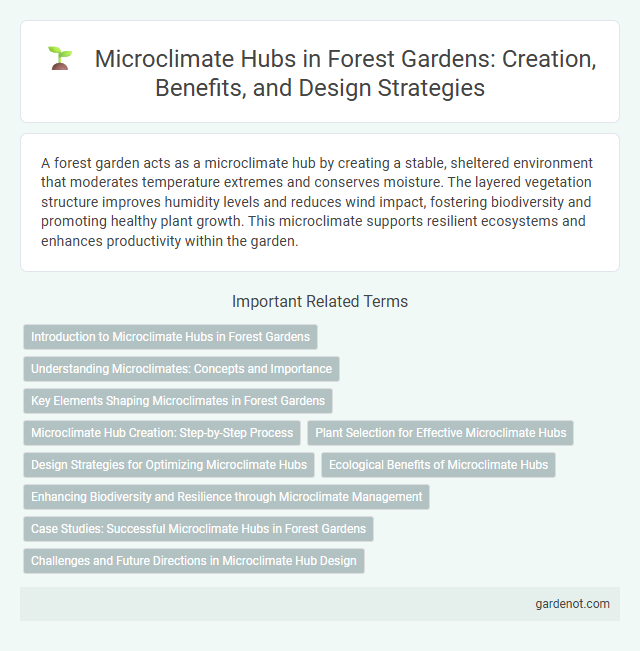A forest garden acts as a microclimate hub by creating a stable, sheltered environment that moderates temperature extremes and conserves moisture. The layered vegetation structure improves humidity levels and reduces wind impact, fostering biodiversity and promoting healthy plant growth. This microclimate supports resilient ecosystems and enhances productivity within the garden.
Introduction to Microclimate Hubs in Forest Gardens
Microclimate hubs in forest gardens act as strategic zones that enhance biodiversity, regulate temperature, and optimize moisture levels to support diverse plant and animal life. These hubs create ideal conditions for microhabitats by combining canopy layers, ground cover, and water features to mitigate environmental stresses. Effective design of microclimate hubs increases resilience against climate variations and promotes sustainable ecosystem productivity.
Understanding Microclimates: Concepts and Importance
A microclimate hub in a forest garden is a vital area where localized weather conditions, such as temperature, humidity, sunlight, and wind patterns, differ from the surrounding environment, directly influencing plant growth and biodiversity. Understanding microclimates enables the strategic placement of species to optimize photosynthesis, water retention, and shelter from harsh elements, enhancing overall ecosystem resilience. Microclimate mapping and monitoring are essential tools for adapting garden design to seasonal and spatial variations, promoting sustainable and productive forest gardening.
Key Elements Shaping Microclimates in Forest Gardens
Key elements shaping microclimates in forest gardens include canopy layers, soil composition, and water availability. Canopy layers regulate sunlight exposure and wind flow, creating diverse temperature and humidity zones. Soil texture and organic matter influence moisture retention, while water sources like ponds or swales stabilize local humidity and support plant growth.
Microclimate Hub Creation: Step-by-Step Process
Microclimate hub creation in a forest garden involves selecting a sheltered location that maximizes sunlight exposure and wind protection to support diverse plant species. Incorporating elements such as water features, rock formations, and layers of vegetation enhances humidity and temperature regulation, fostering beneficial microhabitats. Careful soil amendment and strategic plant placement optimize nutrient cycling and create a resilient ecosystem within the microclimate hub.
Plant Selection for Effective Microclimate Hubs
Plant selection for effective microclimate hubs in forest gardens prioritizes native species with diverse canopy structures and root systems to create stable temperature and humidity levels. Combining nitrogen-fixing plants with moisture-retentive ground covers enhances soil fertility and water retention, supporting resilient microhabitats. Including multi-layered vegetation like shrubs, herbs, and shade-tolerant trees optimizes natural windbreaks and sun exposure, promoting optimal growth conditions.
Design Strategies for Optimizing Microclimate Hubs
Design strategies for optimizing microclimate hubs in forest gardens emphasize layering diverse plant species to regulate temperature and humidity effectively. Incorporating windbreaks, shade trees, and water features enhances thermal comfort and moisture retention, creating a self-sustaining microenvironment. Strategic spatial arrangement and species selection maximize resource efficiency while promoting biodiversity and resilience within the forest garden ecosystem.
Ecological Benefits of Microclimate Hubs
Microclimate hubs within forest gardens create sheltered environments that enhance biodiversity by providing stable temperature, humidity, and wind protection. These hubs support diverse plant and animal species, promote nutrient cycling, and improve soil health through organic matter retention. By moderating extreme weather conditions, microclimate hubs contribute to ecosystem resilience and sustainable forest garden productivity.
Enhancing Biodiversity and Resilience through Microclimate Management
Microclimate hubs in forest gardens create diverse environmental conditions that support a wide range of flora and fauna, boosting biodiversity. By strategically managing factors such as shade, moisture, and wind protection, these hubs enhance ecosystem resilience against climate stressors. This targeted microclimate modulation fosters healthier plant growth and increases the stability of the forest garden ecosystem.
Case Studies: Successful Microclimate Hubs in Forest Gardens
Successful microclimate hubs in forest gardens demonstrate how strategic plant layering and species selection create balanced temperature, humidity, and wind conditions that improve plant growth and resilience. Case studies highlight diverse designs such as multi-story canopy structures and water-retentive soil amendments that optimize sunlight exposure and moisture retention. These hubs enhance biodiversity, support beneficial insect habitats, and increase overall forest garden productivity by mitigating extreme weather effects.
Challenges and Future Directions in Microclimate Hub Design
Microclimate hubs in forest gardens face challenges such as managing temperature fluctuations, ensuring adequate humidity levels, and integrating biodiversity support to sustain resilient ecosystems. Future directions emphasize advanced sensor technology for real-time microclimate monitoring, adaptive design strategies that respond dynamically to environmental changes, and the incorporation of native plant species to enhance natural climate regulation. Embracing these innovations can optimize microclimate hubs, promoting sustainable growth and ecological balance within forest garden systems.
Microclimate hub Infographic

 gardenot.com
gardenot.com